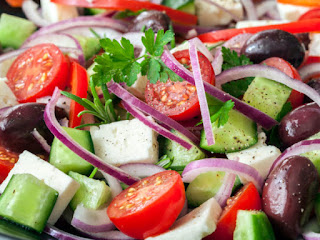Today we will be preparing a salad with us, known under our
name "Greek". Greek salad is traditional not only in Greece, but also
in other Mediterranean countries. The base of the salad is coarsely chopped
fresh vegetables (tomatoes and cucumbers, often also added bell peppers and
onions). A key component of the salad is feta, a traditional Greek cheese made
from sheep or goat milk. Olives and oregano are also put in the salad, seasoned
with olive oil.
It is funny that it is called Greek mainly only in Russia and
among our closest neighbors. In Greece and other Mediterranean countries, you
probably will not find a salad with that name, possibly only in places oriented
towards Russian tourists. The traditional Greek salad in different countries
may have different names, but is most often found under the name Khoriatiki
(from Greek - a rustic salad).
Greek salad (or Choriatics nevertheless) is very popular not
only in Greece and other countries of the Mediterranean, but also in many other
countries of the world, including Russia. The popularity of the salad is easily
explained: it is simply and quickly prepared, thanks to the addition of cheese
and olives it turns out to be quite satisfying, and, what happens not very
often, at the same time tasty and healthy. So, let's get down to cooking, and a
detailed step-by-step recipe with photos will help you prepare a great Greek salad.
Ingredients
- tomatoes 250 g (2 pcs.)
- cucumbers 200 g (2 pcs.)
- Bulgarian pepper 150 g (1 pc.)
- red onion 50 g (1/2 medium onion)
- feta cheese (feta cheese) 100 g
- black olives pitted (olives) 50 g (15-20 pcs.)
- olive oil 20 g (2 tablespoons)
- lemon juice 15 g (1 tablespoon)
- dried oregano 1/2 tsp
- salt
Now let's talk a little bit about the ingredients.
● It seems that everything is simple with vegetables, and it
seems to me that special questions should not arise. It's not so important to
take the ingredients clearly in grams, well, you will have a little more
tomatoes or cucumbers, you will still get a salad. The most important thing is
that they are ripe and tasty, choose those vegetables that are tasty in their
raw form.
● I recommend taking red onions because they, unlike
ordinary onions, have no bitterness and are therefore well suited for salads.
And it looks prettier in a salad than regular onions. Other sweet onions, such
as shallots, can also be used.
● Now let's talk about feta cheese. I specifically write the
more general name of cheese - feta cheese, not Feta, because at present feta
can only be called cheese made from sheep or cow milk, produced only in Greece,
everything else is usually called feta cheese. Cheeses are not being brought to
Russia from Greece now, so there is no way to buy real Feta here, there are
only analogues similar in name to Feta, such as Fetax, Fetaki and others, but
they only look like real Greek cheese by name. Of course, you should not look
for cheeses made from sheep’s milk among them, but even cow’s cheese is now
quite difficult to find, in most cases cheeses based on vegetable fats or with
partial replacement of milk fat with vegetable fat, which manufacturers
honestly write on the packaging. But nevertheless, there are cheeses made from
cow's milk, as a rule, they are sold here under the name Brynza. So carefully
read the information on the label, although this now, unfortunately, is not
always the key to success.
● As a rule, in Greek salad, which is made in Russia, they
put black oxidized olives. These olives, also called olives, are made from
unripe green fruits, and they get their radically black color due to chemical
treatment, which, in addition to color, also helps to remove the bitterness
present in unripe fruits. Olives ripened on a tree are also called “black”, but
in reality they are more likely reddish-brown, dark eggplant or chocolate. In
addition to color, oxidized olives differ from naturally ripened black olives
in their density, which is why producers have the opportunity to take out a
stone from them, natural olives are too soft for such a procedure. In the
Mediterranean countries, naturally ripened black olives with pits are usually
put in salads, it is still customary to use pitted olives (olives) for salads,
so here you decide for yourself which option you prefer, the more authentic or
the one that has already become traditional with us. You can also use green
olives, the only thing you should not take is the stuffed ones, since they are not
at all suitable for a Greek salad.
● Greek salad recipes with lettuce leaves are still common.
In the version that is considered classic, lettuce leaves are not put, and it
seems to me that they are not needed here. But here again, it's up to you, if you
wish, you can add the leaves of any salad here.

Comments
Post a Comment